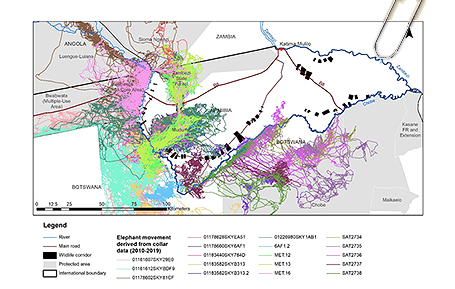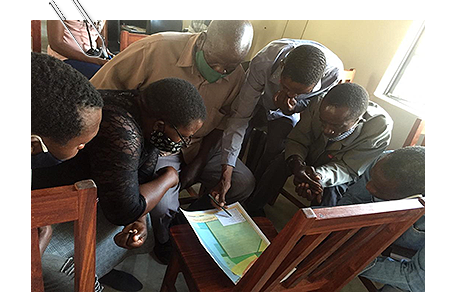Payment for Ecosystem Services in Namibia – Leveraging Conservation Funds for High Value and Endangered Species
Human-wildlife conflict is a prevalent challenge to conservation in almost all protected areas with game species. This is especially true for conservation areas neighboring human habitats, most of which protected areas in Namibia are. Benefits from wildlife tourism such as sector employment, training and entrepreneurship opportunities, etc., has often helped with communities’ tolerance towards predator and other species threatening their livestock and crops.
However, human-wildlife conflict cannot be completely hedged out. On one hand, wildlife numbers grow because of good conservation practice, therefore increasing the number of predator and other potentially destructive species and the resulting conflict incidences. On the other hand, human-wildlife conflict can also be intensified by drought or other climate change factors which increase competition of shared resources between community farmers and wildlife, especially water and grazing resources.
The conservation fraternity in Namibia has therefore been challenged to find additional or better ways to mitigate human-wildlife conflict in protected areas and surroundings, if wildlife is to be conserved and continue to coexist with humans. One of the recently piloted mitigation measures is the Payment for Ecosystem Services (PES) scheme, which aims at generating additional funds from tourism to be used specifically for conservation costs to local communities and their livelihoods. Working with the private sector, WWF-Namibia, the Ministry of Environment, Forestry and Tourism (MEFT) and Integrated Rural Development and Nature Conservation (IRDNC) two PES schemes were piloted in north-east Namibia: the Lion Wildlife Credit scheme and the Elephant Wildlife Credit scheme.
The Lion Wildlife Credit scheme is between Wuparo Conservancy and Nkasa Lupala Lodge in the south of Mudumu National Park. This PES scheme is established with an agreement between the conservancy and the lodge to collect voluntary levies from tourists based on the number of lion sightings during game drives at the lodge. The scheme is progressing well between the conservancy and the Nkasa Lupala lodge, with a total of N$ 56,000.00 collected over eight months between October 2019 and June 2020. It was agreed that this amount shall be used to construct lion-proof kraals in conflict hotspot areas. A total of five lion-proof kraals were constructed by the conservancy for livestock farmers to keep their livestock safe from lions. This way, human-conflict incidences which previously resulted in retaliatory killings of lions by farmers are reduced, and the iconic species is preserved for tourist attraction today and in the future.
The Elephant Wildlife Credit scheme was piloted to develop an elephant economy and sustainable payments to Sobbe and Mashi Conservancies for maintaining elephant corridors, free of village settlements and crop fields between the Zambezi State Forest and Mudumu National Park. IRDNC supported the conservancies in mapping elephants’ natural migration routes which should be reserved as elephant wildlife corridors in the area, and the conservancies are currently in the process of applying to the Zambezi Communal Land Board for obtaining a legal status for the wildlife corridor that will eternally safeguard the corridor from other land uses. This led to Amarula, the liqueur with the elephant as their brand, keen to invest in the protection of the species’ migration corridors. The conservancies’ maintenance of the elephant corridor (i.e. no new settlements and cropping in the corridor), verified by satellite images and wildlife camera traps to spot passing elephants, had Amarula awarding the conservancies with N$ 40,000.00 in March 2018, another N$ 40,000.00 in January 2019; and N$ 50,000 for 2020.
In the Kunene Region in the north-west of Namibia, implementation of some aspects of the Elephant Wildlife Credit, which includes activities required to support the development of a marketable wildlife credit for targeted conservancies, have gained some momentum. One example is the implementation of an elephant monitoring system led by WWF-Namibia. The monitoring system would enable the community game guards to get a better understanding of the elephants and sightings in their conservancies, which is critical for setting up a marketable wildlife credit. A training on the new monitoring system was completed by WWF Namibia, supported by IRDNC Coordinators. A total of 12 community game guards from six conservancies (Otuzemba, Orupupa, Okangundumba, Ozondundu, Puros and Ongongo) attended the training in November 2020. The official collection of data using the monitoring system already started in December 2020 by four conservancies (Otuzemba, Okangundumba, Ozondundu and Ongongo). Observations and feedback are that the conservancies are now using the monitoring system and once the data is downloaded, the conservancies and the support team will know how effective the monitoring has been.
Both the Lion and Elephant Wildlife Credit schemes were a tremendous success for conservation in Namibia. Additional opportunities to further test the PES schemes have already been identified between conservancies and private sector partners. Four eastern floodplain conservancies (Salambala, Nakabolelwa, Kasika and Kabulabula) and Serondela Lodge in Namibia and other lodges in Botswana are currently looking into developing a PES scheme. Wildlife corridors in the eastern flood plain conservancies in Zambezi region also provide free movement of other game especially Zebras from Makgadikgadi in Botswana to Sikunga conservancy on the Zambezi River. Mayuni and Kwandu Conservancies each have three wildlife corridors identified, which include animals such as kudus, elands, buffalos, wild dogs, elephants and lions, which can be further supported through the PES model.
Individual conservancies were planning to match fund contributions from donors and the private sector, however, plans were delayed due to restrictions of international travel and the effects this has on tourism sector activities. The PES project is at this time dependent on the private sector to provide funding for the Wildlife Credit payments, and it may take some time to achieve the objectives anticipated. Fortunately, the lodges in both Namibia and Botswana who committed to this project earlier are still fully invested despite the impacts of COVID-19.

- Elephant migration corridors identified in north-east Namibia

- Sobbe Conservancy representatives identifying their elephant corridors on the map



